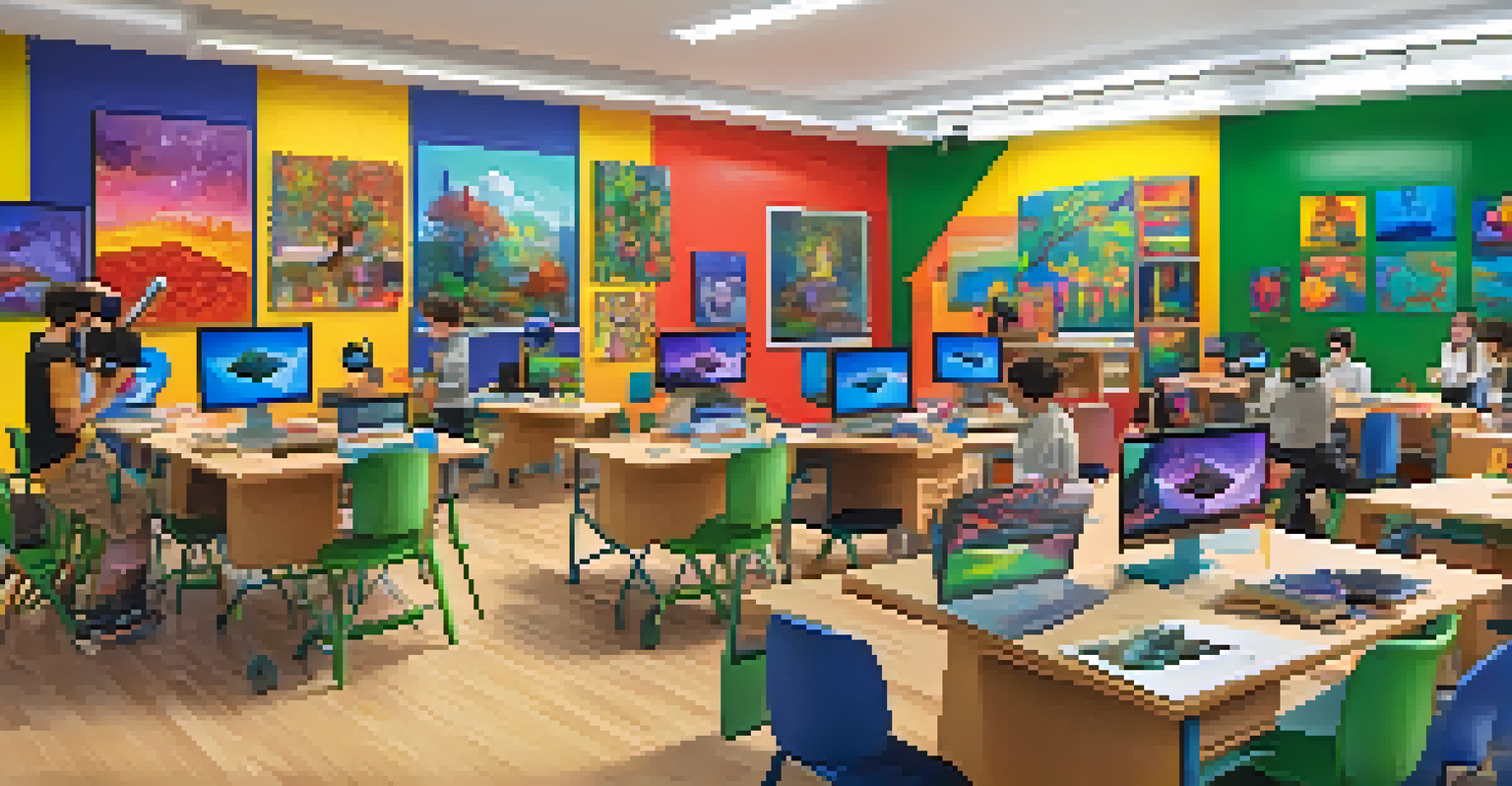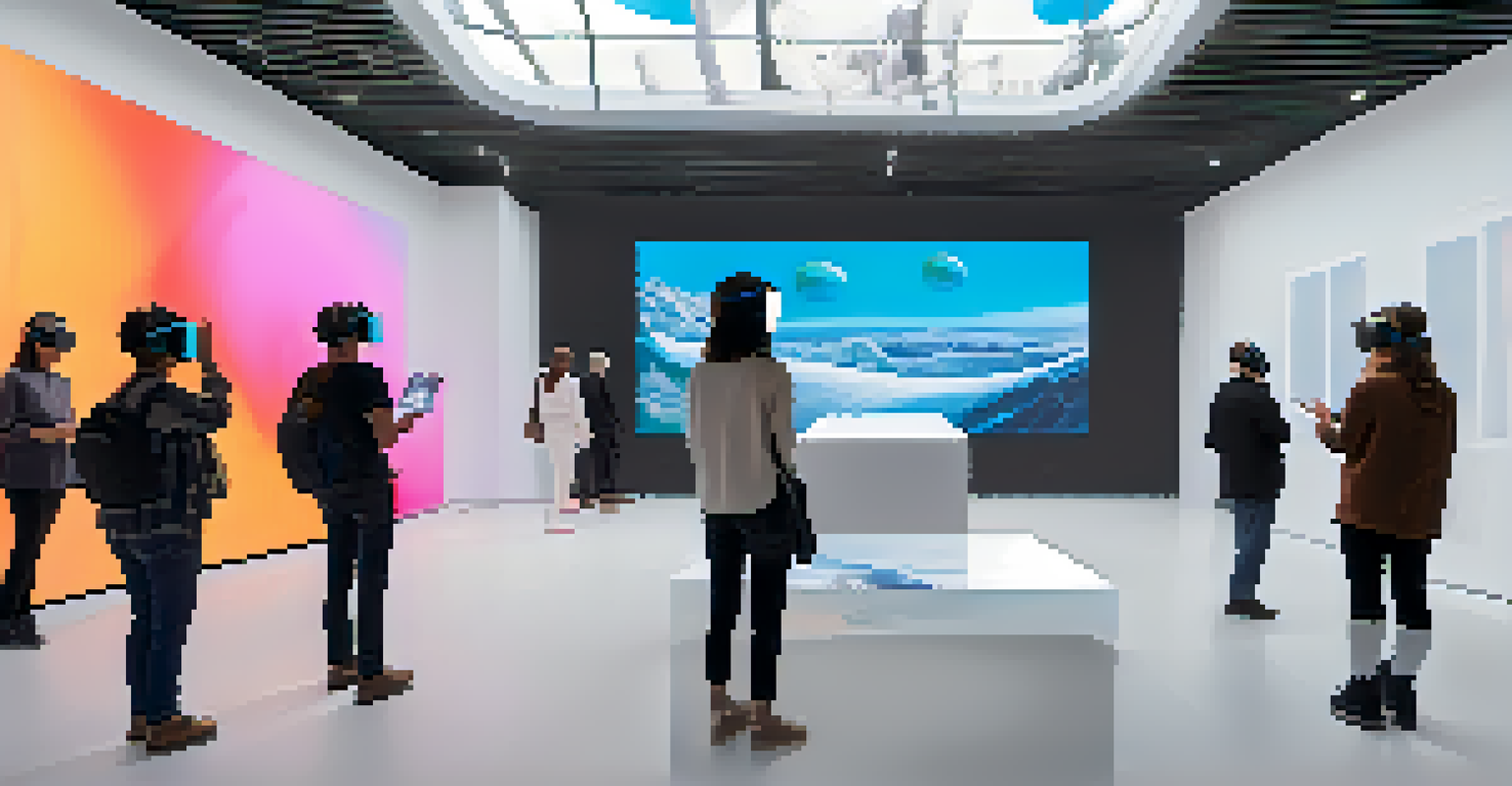The Role of Virtual Reality in Contemporary Art Practices Today

Understanding Virtual Reality in Art
Virtual reality (VR) is a technology that immerses users in a simulated environment, often through a headset. In the context of art, it transforms how both artists and audiences engage with creative expressions. By allowing viewers to step inside a 3D artwork, VR breaks traditional boundaries of viewing art in galleries and museums.
Art is not a mirror held up to reality, but a hammer with which to shape it.
For instance, artists can create entire worlds that viewers can explore, making the experience more interactive and personal. Imagine walking through a painting, where the colors and shapes come alive around you. This shift not only enhances the emotional connection to the artwork but also invites new interpretations.
As artists embrace VR, they are redefining their practices, utilizing the medium to push the limits of creativity. This evolution reflects a broader trend in contemporary art, where technology and traditional methods often intertwine, creating a vibrant dialogue between the two.
How Artists Are Using VR Today
Many contemporary artists are incorporating VR into their work to explore complex themes and narratives. For example, some use VR to address social issues, allowing audiences to experience perspectives they may not encounter in everyday life. This immersive storytelling approach can provoke empathy and understanding, making art a powerful tool for social change.

Moreover, artists like Jon Rafman have created virtual exhibitions that invite viewers into surreal environments, merging the digital and physical realms. These experiences can be both captivating and thought-provoking, challenging the conventional understanding of art and its role in society.
VR Transforms Artistic Engagement
Virtual reality allows audiences to actively participate in art, creating immersive experiences that deepen emotional connections.
By using VR, artists are no longer limited to a canvas or a sculpture; they can craft entire experiences that engage multiple senses. This shift is indicative of how contemporary art continually evolves, reflecting changes in technology, culture, and the human experience.
The Audience Experience in Virtual Reality Art
One of the most significant shifts that VR brings to contemporary art is the way audiences experience it. In traditional settings, viewers are often passive observers, but VR invites active participation. When immersed in a VR art piece, audiences can explore, interact, and even influence the narrative, creating a sense of agency that was previously absent.
The best way to predict the future is to create it.
For instance, consider a VR artwork that allows you to choose different paths or outcomes as you navigate through the piece. This level of engagement transforms the viewer into a co-creator, fostering a deeper connection to the art. The experience becomes personal, as each viewer's journey may differ based on their choices.
This shift in audience engagement not only enhances enjoyment but also opens up discussions about interpretation and meaning. As individuals navigate through these virtual landscapes, they bring their own experiences and perspectives into play, enriching the overall experience of the artwork.
Challenges Artists Face with VR Technology
While the potential of VR in art is vast, artists encounter several challenges when integrating this technology into their practices. One of the primary hurdles is the cost associated with VR equipment and software, which can be prohibitive for many emerging artists. This limitation can result in a lack of diversity in the types of narratives and experiences presented in VR art.
Additionally, mastering VR technology requires a steep learning curve, as artists must familiarize themselves with new tools and platforms. This can be daunting, especially for those more accustomed to traditional mediums. However, as VR becomes more mainstream, resources and training opportunities are gradually increasing.
Artists Face VR Integration Challenges
Many artists struggle with the costs and learning curves associated with VR technology, which can limit their creative expression.
Despite these challenges, many artists are finding innovative ways to incorporate VR into their work. By collaborating with technologists or participating in workshops, they are overcoming obstacles and pushing the boundaries of what virtual art can achieve.
The Role of VR in Art Education
Virtual reality is also making waves in art education, offering students new ways to learn about and create art. With VR, students can visit virtual galleries or historical art sites without leaving the classroom, providing a rich, immersive learning experience. This technology expands access to art history and theory, making it more engaging and relatable.
Moreover, VR tools enable students to experiment with their creativity in a virtual space, where mistakes can be made without the fear of ruining a physical piece. This freedom fosters innovation and exploration, encouraging students to think outside the box and develop their unique artistic voice.
As educators embrace VR, there’s potential for a transformative impact on how art is taught and understood. By blending traditional techniques with modern technology, the next generation of artists can emerge equipped with a diverse skill set.
The Future of Virtual Reality in Contemporary Art
The future of virtual reality in contemporary art looks promising, with technology constantly evolving and becoming more accessible. As hardware becomes cheaper and software improves, more artists are likely to experiment with VR, pushing the boundaries of creativity even further. This democratization of technology could lead to a surge of diverse voices and stories within the medium.
Furthermore, as audiences become more familiar with VR, their expectations for art experiences will also evolve. Artists will need to continually innovate to capture and maintain viewer interest, leading to exciting new forms of artistic expression. The interplay between traditional art forms and VR will likely create hybrid experiences that challenge and redefine the boundaries of art.
VR Enhances Art Education
Virtual reality provides students with innovative ways to explore art history and develop their artistic skills in a risk-free environment.
In essence, the integration of virtual reality into contemporary art practices signifies a broader shift towards inclusivity and interactivity in the art world. As artists and audiences navigate this new landscape together, we may witness the emergence of art that resonates on deeper levels, transforming the way we perceive creativity.
Conclusion: Embracing the New Art Frontier
Virtual reality is undeniably reshaping the contemporary art landscape, offering both artists and audiences new ways to connect and create. From immersive experiences that encourage empathy to innovative educational tools that inspire the next generation, VR is opening doors to uncharted territories in art. As this technology continues to evolve, the possibilities for artistic expression are boundless.
It’s essential for artists, educators, and audiences alike to embrace this new frontier, understanding that technology can serve as a catalyst for creativity and connection. By welcoming VR into the art world, we are not only enriching our experiences but also fostering a culture of exploration and innovation.

As we look ahead, the potential for virtual reality in art practices is exciting, and its impact on the future of creativity will be profound. Whether you’re an artist, a viewer, or simply an enthusiast, there’s never been a better time to engage with the evolving landscape of contemporary art.